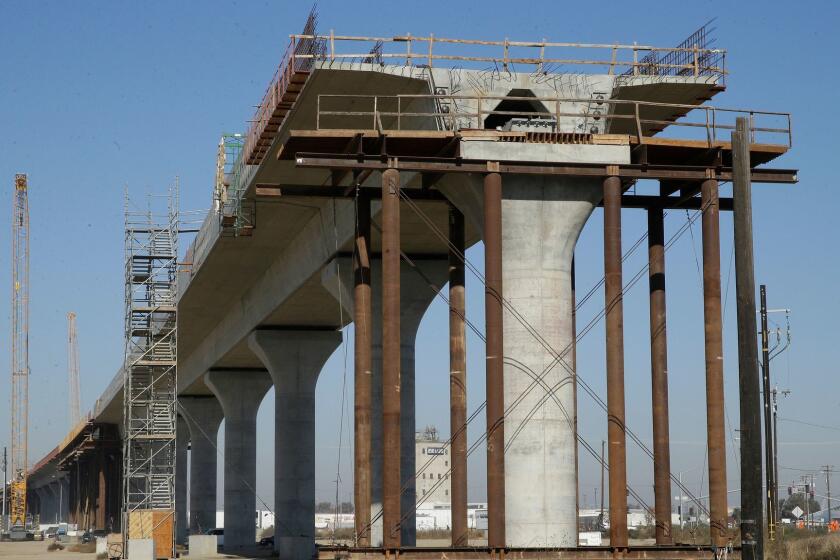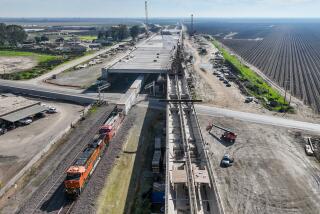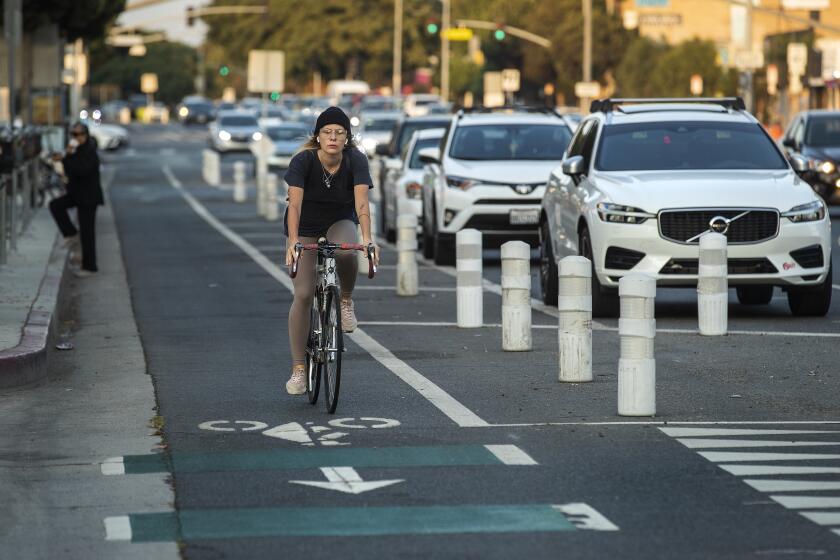Cost overruns hit California bullet train again amid a new financial crunch

- Share via
The California bullet train is facing at least another billion dollars of proposed cost increases from its contractors, following a history of sharp cost growth on construction work over the last eight years, The Times has learned.
The state’s High-Speed Rail Authority has mostly approved such increases in the past, and if it does so again, contractors could proceed with one of the biggest price escalations since bullet train construction began in the San Joaquin Valley.
The continued cost increases — and the likelihood of similar problems surfacing over the next few years — are deepening the already difficult financial condition of the $100-billion project.
The state has budgeted $22.8 billion to build a partial segment from Bakersfield to Merced. Originally, construction of the Los Angeles to San Francisco system was pegged at $33 billion. But the surging costs will probably force the state to dig deeper into its future funding just to complete that 171-mile leg in the valley.
The teams building bridges, viaducts, trenches and overpasses in the valley have submitted dozens of new claims for delays and design changes, asserting they are the authority’s fault, according to several of the project’s technical and business officials and internal documents reviewed by The Times. The officials asked to remain nameless because they were not authorized to talk to the media.
The costs are being driven by changes in designs submitted in the original contracts, delays in moving underground utilities and long-standing problems buying all of the land along the right of way.
Rail authority Chief Executive Brian Kelly declined to discuss the size of the cost increases, but said they are growing due to erroneous past decisions. Kelly, who became CEO in January 2018, said he had fully expected some of the additional construction expenses, because not all of the designs were completed when contracts were previously issued.
In an interview, Kelly said, “I do not endorse their numbers. We do not see the evaluations the same way,” but added that he has been prepared for the potential overruns.
“I have budgeted for those costs. It is not new,” Kelly said, adding that the project is addressing past problems and will avoid repeating them in the future.
In May, Kelly issued a written report that acknowledged there were significant pending change orders, though it did not include the proposed prices. The report indicated that at least some of the proposed change orders were in dispute.
Only two years ago, the California rail authority unveiled an ambitious plan to begin operating a segment of bullet train service between San Jose and the Central Valley by 2025.
The scope of the new cost increases has not been disclosed in any public documents and the rail authority has declined to provide lawmakers with updates on change orders as they are submitted by contractors. Under rail authority policy, change orders are only disclosed after they are approved.
Assemblywoman Laura Friedman (D-Glendale), chairwoman of the Assembly Transportation Committee, has urged the rail authority to amend its plans as the costs have risen.
“You have to make sure people support this project as the costs continue to rise,” she said in an interview. “It is safe to say this is going to be a very expensive project. What we want is that it has to have utility to a lot of people on the day it opens.”
Friedman said the current plan to build the segment from Bakersfield to Merced will not demonstrate the value of high-speed rail unless it provides services to major urban areas. Speaker Anthony Rendon (D-Lakewood) has sought to transfer some of the funds from the Central Valley to high-speed rail segments in Southern California and the Bay Area.
Friedman led the negotiations for the Legislature on the appropriations. She said the Legislature offered Gov. Gavin Newsom $1 billion for construction and another $1.5 billion for change orders in August. The offer indicates that the Legislature appears braced for growing costs.
But Newsom held out for the full $4.2 billion, according to officials close to the negotiations. Friedman, backed by a large contingent of Assembly Democrats, wants to withhold some of the $4.2 billion in funding to retain control over the troubled project.
In the interview, Kelly said he did not want to discuss the details of the negotiations. But he said it was important for the rail authority to have confidence in its revenue sources to plan and execute future construction.
Whether change orders can be controlled is problematic. At its September meeting, the board adopted a new “change order control committee,” which would increase internal scrutiny and improve documentation, though it may not reduce their volume. Kelly said he did not think the committee could have prevented any of the past change orders if it had existed years ago.
The board has limited ability to intervene. Board members are not provided with proposed change orders or their proposed amounts before the staff approves them, according to two former board members.
Efforts to strengthen outside control of the project have also faltered. In 2016, then Gov. Jerry Brown vetoed bipartisan legislation to strengthen oversight.
The bulk of the change orders come from two teams, building rail segments through Madera, Fresno and Kings counties in the heart of the San Joaquin farm belt.
Tutor Perini, which leads a team that is building about 31 miles of rail structures around Fresno, has submitted paperwork seeking about $600 million in additional payments, according to multiple sources familiar with the matter.
So far, the team has received approval of 383 past change orders that largely accounted for its contract growing from $1 billion to $2.4 billion. Among Tutor Perini’s demands that the rail authority approved was $50,410.40 for 15 months of local and long-distance calls, according to records.
Included in the new filings is a claim for $131 million for delays that the company says were caused by the rail authority’s failure to obtain land for the construction and to complete utility relocations along the right of way. The project still needs 370 more parcels of land and in the most recent month acquired only nine pieces of land. Other claims involve design changes for various east-to-west highway overpasses across the future bullet train tracks.
Dragados, the Spanish construction firm that is leading a team for 65 miles of work around Kings County, has submitted new delay claims and change orders of more than a half-billion dollars, according to officials and documents. It has already received approval of 297 prior change orders that boosted its contract from $1.4 billion to $2.1 billion.
Officials at Dragados and Tutor Perini declined requests for comment.
The biggest immediate problem for California’s high-speed rail project is land acquisitions. Mismanagement of them is contributing to construction delays, cost increases, litigation and the launch of a federal audit.
The pace of construction remains well below the budgeted level across the San Joaquin Valley, as each month the project fails to meet its projected spending rate. In the most recent report, for example, Tutor Perini was scheduled to build $49 million worth of structures in July, but completed only $28 million.
So far in 2021, the Tutor Perini team has averaged construction of $22.5 million per month and has a remaining contract balance of $845.1 million. At the current rate of progress, the Tutor Perini segment is likely to be completed by mid-2024, according to a Times analysis of rail authority progress reports and the judgment of officials in the project.
Dragados is working even slower, invoicing $16.25 million per month with a remaining balance of $740.6 million, indicating a completion of its work by mid-2025 or later. Officials close to the project expect work to drag on for both segments until about 2026, years past the current scheduled completion in 2022. The rail authority is in the process of revising the completion dates, the officials said.
The delays should be covered by the state, the firms contend. But Kelly said that the rail authority will dispute at least some of the Dragados demands, including two creek crossings and collision barriers along the future tracks.
Tutor Perini and Dragados have a large volume of additional orders that have not yet been submitted to the authority, which could add hundreds of million of dollars in additional demands, according to officials who described the change orders.
The Legislature has grown more concerned about the project and refused in August to appropriate the $4.2 billion that Newsom requested in the session that ended in August.
The deadlock in negotiations forced the rail authority in late September to cut the construction budget in the Central Valley by $900 million over the next year. The cutbacks could be reversed if and when the Legislature approves the appropriation.
But at its September board meeting, the authority said the lack of appropriation would cause it to delay work on laying its first track, a high-voltage electrical system and installing a complex signaling system to control trains.
The current plan would start train operations by 2030, but officials working on the project say privately that it appears difficult, if not impossible, to meet that timetable.
More to Read
Sign up for Essential California
The most important California stories and recommendations in your inbox every morning.
You may occasionally receive promotional content from the Los Angeles Times.











